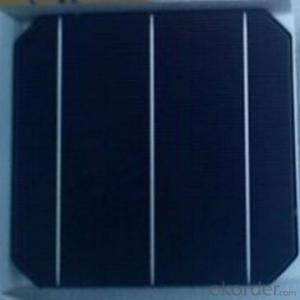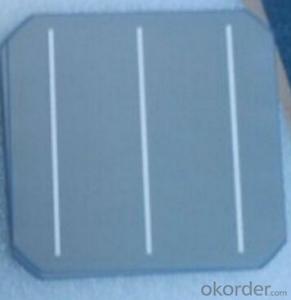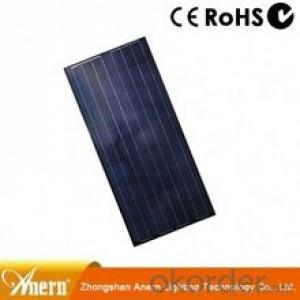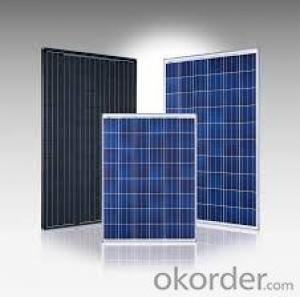Monocrystalline Solar Cells Series-- 18.2%
- Loading Port:
- Shanghai
- Payment Terms:
- TT OR LC
- Min Order Qty:
- 1000 pc
- Supply Capability:
- 100000 pc/month
OKorder Service Pledge
OKorder Financial Service
You Might Also Like
Solar Cells:
Solar cells is made by solar wafer, it has three categories of solar cell right now, monocrystalline polycrystalline and thin film,These cells are entirely based around the concept PNjunction, which is the critical part of solar module, it is the part that can convert the light energy into electricity, the thickness is from 180um to 200um, with even busbars to conduct electricity, textured cell can decrease diffuse reflection; they are often electrically connected and encapsulated as a module. Photovoltaic modules often have a sheet of glass on the front (sun up) side, allowing light to pass while protecting semiconductor wafers from abrasion and impact due to wind-driven debris, rain, hail, etc. Solar cells are also usually connected in series in modules, creating an additive voltage. Connecting cells in parallel will yield a higher current;With high quality and stable quality. Our Cells can greatly improve the performance of Solar Modules.
Features:
High conversion efficiencies resulting in superior power output performance.
Outstanding power output even in low light or high temperature conditions
Optimized design for ease of soldering and lamination
Long-term stability,reliability and performance
Low breakage rate
Color uniformity
Specifications:
Dimension: 156mm±0.5mm
Wafer Thickness: 200μm±20μm
Diagonal: 200mm±1.0mm(round chamfers)
Front: 1.5mm Silver bus bars; Blue/others silicon nitride antireflection coating
Back: 3.0mm Silver bus bars; Full-surface aluminum BSF
Efficiency | Efficiency | Pmax(W) | Average | Impp(A) | Vmpp(V) | Isc(A) | Voc(V) |
1840 | 18.30-18.50 | >4.371 | >4.371 | 8.285 | 0.530 | 8.695 | 0.626 |
1820 | 18.10-18.30 | 4.323-4.371 | 4.347 | 8.245 | 0.528 | 8.662 | 0.626 |
1800 | 17.90-18.10 | 4.276-4.323 | 4.299 | 8.190 | 0.526 | 8.630 | 0.625 |
1780 | 17.70-17.90 | 4.228-4.276 | 4.252 | 8.140 | 0.524 | 8.621 | 0.624 |
1760 | 17.50-17.70 | 4.180-4.228 | 4.204 | 8.095 | 0.522 | 8.598 | 0.623 |
1740 | 17.30-17.50 | 4.132-4.180 | 4.156 | 8.045 | 0.520 | 8.568 | 0.622 |
1720 | 17.10-17.30 | 4.085-4.132 | 4.108 | 7.905 | 0.518 | 8.528 | 0.620 |

Solar Cells Advantage:
• High efficiency and stable performance in photovoltaic conversion.
• Advanced diffusion technique ensuring the homogeneity of energy conversion efficiency of the cell.
• Advanced PECVD film forming, providing a dark blue silicon nitride anti-reflection film of homogenous color and attractive appearance.
• High quality metal paste for back surface and electrode, ensuring good conductivity, high pulling strength and ease of soldering.
FAQ
We have organized several common questions for our clients,may help you sincerely:
①What price for each watt?
It depends on the efficiency of the solar cell, quantity, delivery date and payment terms.
②How long can we receive the product after purchase?
In the purchase of product within three working days, We will arrange the factory delivery as soon as possible. The pecific time of receiving is related to the state and position of customers.Commonly 7 to 10 working days can be served.
③Can you provide the peripheral products of the solar panels, such as the battery, controller, and inverter? If so, can you tell me how do they match each other?
Yes, we can, we have two companies for solar region, one is CNBM International, the other is CNBM engineering Co.
We can provide you not only the solar module but also the off grid solar system, we can also provide you service with on grid plant.
④What is your warranty of solar cell?
Our product can promise lower than 0.3% open box crack, we support claim after opening the box if it has crackm color difference or sth, the buyer should give pictures immediately, we can not accept the claim after the solar cell has assembled to solar panel.
• Timeliness of delivery
• ⑤How do you pack your products?
We have rich experience on how to pack the solar cell to make sure the safety on shipment, we could use wooden box or pallet as buyer's preference.
- Q:Can solar cells be used for water heating?
- Yes, solar cells can be used for water heating. Solar thermal systems use solar energy to heat water directly, while solar photovoltaic systems can generate electricity to power water heaters. Both methods are efficient and environmentally friendly alternatives to traditional water heating systems.
- Q:Can solar cells be used to power remote oil and gas monitoring systems?
- Yes, solar cells can be used to power remote oil and gas monitoring systems. Solar cells are a reliable and sustainable source of renewable energy that can be used to generate electricity in remote locations where access to the grid is limited. By harnessing the power of the sun, solar cells can provide a continuous supply of electricity to power monitoring systems for oil and gas operations, ensuring efficient and reliable monitoring in remote areas. Additionally, solar power offers environmental benefits by reducing reliance on fossil fuels and minimizing carbon emissions.
- Q:Can solar cells be used to power parking meters?
- Yes, solar cells can be used to power parking meters. Solar cells convert sunlight into electricity, making them a sustainable and environmentally friendly power source for various applications, including parking meters. By harnessing solar energy, parking meters can operate independently, reducing the need for frequent battery replacements or connection to the electrical grid.
- Q:Can solar cells be used in desert areas?
- Yes, solar cells can be used in desert areas. In fact, desert regions are ideal for solar energy production due to their high levels of sunlight and low cloud cover. The arid conditions also help keep solar panels clean and free from debris, maximizing their efficiency.
- Q:What is the impact of dust or dirt on solar cell performance?
- The presence of dust or dirt on solar cells can have a significant impact on their performance. It can reduce the amount of sunlight reaching the cells, thereby decreasing their efficiency in converting sunlight into electricity. The accumulation of dust or dirt can create a barrier between the sunlight and the cells, preventing the photons from effectively interacting with the semiconductor material. This can result in a decrease in power output and overall energy generation. Regular cleaning and maintenance of solar panels are essential to ensure optimal performance and maximize energy production.
- Q:What is a monocrystalline solar cell?
- A monocrystalline solar cell is a type of solar panel that is made from a single crystal structure, typically silicon. It is known for its high efficiency and sleek, black appearance. The single crystal structure allows for better electron flow, resulting in greater energy conversion from sunlight into electricity.
- Q:Can solar cells be used in data centers?
- Yes, solar cells can be used in data centers. They can be installed on the roofs or surrounding areas of data centers to generate clean and renewable energy. This helps reduce the reliance on grid power and lowers the carbon footprint of the data center operations. However, the feasibility and effectiveness of using solar cells in a data center would depend on factors such as the available space, climate conditions, and energy requirements of the facility.
- Q:What materials are used in solar cells?
- The most common materials used in solar cells are silicon, which is the dominant material in the market, as well as other materials such as cadmium telluride, copper indium gallium selenide, and organic materials like polymers.
- Q:Can solar cells be used in mobile devices?
- Yes, solar cells can be used in mobile devices. In fact, there are already several mobile devices available in the market that are equipped with solar panels to harness solar energy and charge their batteries. These solar-powered mobile devices are particularly useful in situations where access to electricity is limited or unavailable.
- Q:I am a purchasing manager for a EPC engineering company, and we are planning to purchasing some 4bb solar cells for one of our project in Taiwan, can I get a quotation online?
- We are a professional company selling solar cells. Tomi Fuji is dedicated to provide high quality solar products, ranging from Photovoltaic (PV) cells, PV modules to PV power systems. You can trust us to get the best quality product with the best price.
1. Manufacturer Overview |
|
|---|---|
| Location | |
| Year Established | |
| Annual Output Value | |
| Main Markets | |
| Company Certifications | |
2. Manufacturer Certificates |
|
|---|---|
| a) Certification Name | |
| Range | |
| Reference | |
| Validity Period | |
3. Manufacturer Capability |
|
|---|---|
| a)Trade Capacity | |
| Nearest Port | |
| Export Percentage | |
| No.of Employees in Trade Department | |
| Language Spoken: | |
| b)Factory Information | |
| Factory Size: | |
| No. of Production Lines | |
| Contract Manufacturing | |
| Product Price Range | |
Send your message to us
Monocrystalline Solar Cells Series-- 18.2%
- Loading Port:
- Shanghai
- Payment Terms:
- TT OR LC
- Min Order Qty:
- 1000 pc
- Supply Capability:
- 100000 pc/month
OKorder Service Pledge
OKorder Financial Service
Similar products
New products
Hot products
Hot Searches
Related keywords


























